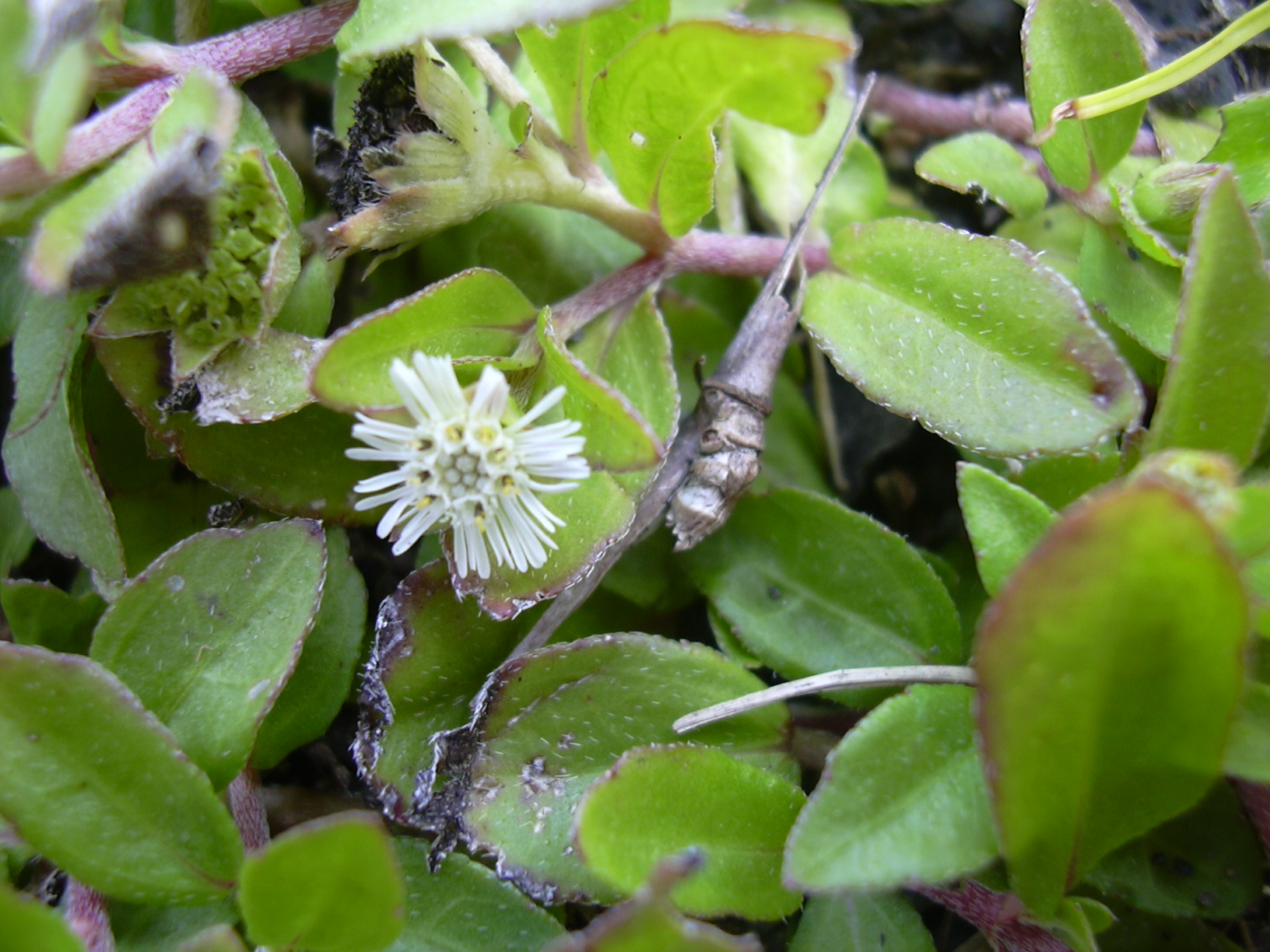- Eclipta alba
image_width = 260px
regnum =Plant ae
divisio = Magnoliophyta
classis =Magnoliopsida
ordo =Asterales
familia =Asteraceae
genus = "Eclipta "
species = "E. alba"
binomial = "Eclipta alba"
binomial_authority = (L.) Hassk.
synonyms = "Eclipta erecta"
"Eclipta prostrata"
"Verbesina alba"
"Verbesina prostrata""Eclipta alba" (L.) Hassk. (
syn. "Eclipta prostrata" L.), commonly known as False Daisy , yerba de tago, and bhringraj, is a plant belonging to the family Asteraceae. Root well developed, cylindrical, greyish. Floral heads 6-8mm in diameter, solitary, white, achene compressed and narrowly winged. It grows commonly in moist places as a weed all over the world. It is widely distributed throughoutIndia ,China ,Thailand , andBrazil . In "ayurvedic" medicine, the leaf extract is considered a powerful liver tonic, rejuvenative, and especially good for the hair. A black dye obtained from "Eclipta alba" is used for dyeing hair and tattooing. "Eclipta alba" also has traditional external uses, like athlete foot, eczema and dermatitis, on the scalp to address hair loss and the leaves have been used in the treatment of scorpion stings. It is used as anti-venom against snakebite in China and Brazil (Mors, 1991). It is reported to improve hair growth and colour (Kritikar and Basu 1975 and Chopra "et al." 1955)The herb "Eclipta alba" contains mainly
coumestan s i.e.wedelolactone (I) and demethylwedelolactone (II), polypeptides, polyacetylenes, thiophene-derivatives, steroids, triterpenes and flavonoids. Coumestans are known to possess estrogenic activity (Bickoff "et al." 1969) Wedelolactone possesses a wide range of biological activities and is used for the treatment of hepatitis and cirrhosis (Wagner "et al." 1986), as an antibacterial, anti-hemorrhagic (Kosuge "et al." 1985). and for direct inhibition of IKK complex resulting in suppression of LPS-induced caspase-11 expression (Kobori "et al". 2004)Traditional uses
Plant is bitter, hot, sharp, dry in taste and is used in "ayurveda" for the treatment of "Kapha" and "Vata" imbalances. In India, the plant is known as "bhangra", "bhringaraj" or "bhringraja". Another plant "Widelia calendulacea" is also known by the same name, but "Eclipta" has white flowers so called white "bhangra" and "Widelia" has yellow flower so it is called yellow "Bhangra" (Puri 2003).
The expressed leaf juice is applied along with honey is a popular remedy for catarrh in infants. A preparation obtained from the leaf juice boiled with sesame or coconut oil is used for anointing the head to render the hair black and luxuriant. An oil prepared with "amla," "bhringraj" and sometimes with "brahmi" is well known in India as Amla Bhringraj oil, which is said to blacken the hair. Plant is rubbed on the gums in toothache and applied with a little oil for relieving headache and with sesame oil in elephantiasis. Roots of "Eclipta alba" are emetic and purgative.
In Ayurveda the plant is considered a "rasayana" for longevity and rejuvenation. Recent studies have shown that it has a profound
antihepatotoxic activity. A cardiodepressant activity was also observed in it when used for hepatic congestion. A complete symptomatic relief in epigastric pain, nausea and vomiting in ulcer patients has also been observed (Puri 2003)In Taiwan, entire plant is used as a remedy for the treatment of bleeding, heamoptysis, haematuria and itching, hepatitis, diphtheria and diarrhoea. In China, as a cooling and restorative herb, which supports the mind, nerves, liver and eyes. The leaf extract is considered to be powerful liver tonic, rejuvenative, and especially good for the hair. A black dye obtained from "Eclipta alba" is also for dyeing hair and tattooing. "Eclipta alba" also has traditional external uses, like athlete foot, eczema and dermatitis, on the scalp to address hair loss and the leaves have been used in the treatment of scorpion strings. It is used as anti-venom against snakebite in China and Brazil (Mors, 1991).
References
*Chopra, RN., Nayar, SL., Chopra, IC.,1955. "Glossary of Indian Medicinal plants." C.S.I.R., New Delhi.
* ISBN 0-89672-614-2
*Kritikar, KR., Basu, BD. 1975. "Chronica Botanica Indian Medicinal plants". New Delhi.
*Puri, HS 2003 "Rasayana: Ayurvedic Herbs for Longevity and Rejuvenation". Taylor & Francis, London, pages 80-85External links
* [http://ucjeps.berkeley.edu/cgi-bin/get_JM_treatment.pl?609,1065,1066 Jepson Manual Treatment]
* [http://plants.usda.gov/java/profile?symbol=ECPR USDA Plants Profile]
Wikimedia Foundation. 2010.

